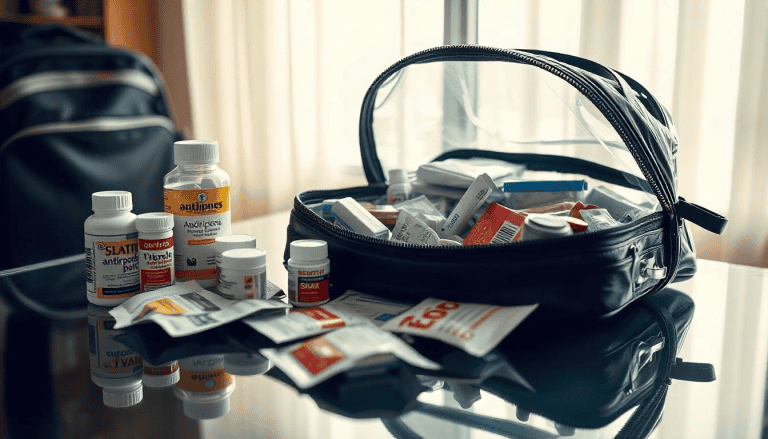Simplify Air Travel with Meds: Free Doctor’s Letter Template

Have you ever felt a wave of anxiety when thinking about explaining your medications or medical devices to a TSA agent or customs officer? Traveling can already be stressful, but when you add in the worry of carrying necessary medications, medical devices, or even controlled substances, it can feel overwhelming.
That’s where a travel letter from your doctor comes in. This simple document will simplify air travel with meds; it will enable you to arrive at the airport, feeling prepared and empowered rather than frazzled, because you have everything you need to answer any questions about your medical items.
In this guide, we’ll explore how a travel letter works, when you need one, and how to use it effectively during your travels. You’ll also find actionable tips, real-world scenarios, and answers to common questions that travelers with medications and medical devices often face.
Be sure to check out our comprehensive guide to Flying with Medications for specifics on air travel with pills, injectable meds and more and Flying with Medical Devices if you travel with a CPAP, insulin, a pacemaker, etc.
1. Why You Need a Travel Letter: TSA vs. Customs
A travel letter from your doctor is more than just a piece of paper—it’s your safeguard against unnecessary stress and confusion during airport screenings and customs inspections. Whether you’re flying domestically or internationally, it simplifies interactions with security personnel and ensures you can carry essential medications and devices without unnecessary hassle.
1.1 For TSA (Domestic Flights): Screening Medications and Devices

TSA agents are responsible for screening passengers who are flying throught the US. While TSA allows you to bring medically necessary items such as prescription medications, syringes, and medical devices, these items often require documentation. Here’s how a travel letter helps at TSA checkpoints:
- It streamlines the process: TSA officers may question items that don’t fit standard guidelines, such as liquid medications exceeding 3.4 ounces. When you are traveling with a child who requires prescription cough medicine you will be grateful for that letter; without it, it may be prohibited by an agent.
- It avoids confusion with unfamiliar devices: If you’re traveling with a medical device like a CPAP machine or insulin pump, a travel letter verifies that it’s a necessary medical tool, reducing the likelihood of additional screening.
- It reduces misunderstandings: TSA agents handle thousands of passengers daily and may not always be familiar with certain medications or devices. A doctor’s explanation adds credibility and clarity.
KEEN TIP: Does your medication require refrigeration? Make sure your travel letter states that you need gel or ice packs to keep those meds at the right temperature.
1.2 For Customs (International Flights): Preventing Confiscation
International travel adds another layer of complexity. Customs regulations vary by country, and some medications that are perfectly legal in the U.S. may be restricted or prohibited abroad. A travel letter helps you navigate these challenges.
For example, if you’re carrying controlled substances, customs can seize your medication. In addition, you might inadvertently be carrying a precription or over-the-counter substance that is either restricted or banned in your destination country. Your doctor’s letter explains the medical necessity and increases your chances that you may continue your journey with your meds.
Try to get that travel letter translated: In non-English-speaking countries, customs officials may not understand your medications or their purpose. A translated travel letter can clarify your needs and smooth the process. If you’re unable to get a translated letter, ask for a supervisor.
KEEN TIP: Before traveling internationally, research the specific medication rules by looking up your destination on the US Embassy website or your country’s embassy site. Some destinations will require additional documentation, like a notarized copy of the prescription or prior approval for controlled substances.
2. What to Include in a Doctor’s Travel Letter
We offer a free template below that you can bring to your doctor so he can create a letter easily. It should cover the following
Your Name, Medical Condition, and Prescribed Medications/Devices
- Your Full Name: Ensure it matches the name on your passport or other travel documents to avoid discrepancies. This is important.
- Medical Condition: A brief description of the condition requiring the medications or devices. This doesn’t have to be overly detailed—just enough to explain why the items are necessary.
- Example: “This patient has Type 1 diabetes and requires insulin therapy to manage their condition.”
- List of Medications or Devices: Include the names of all prescription medications and any medical devices you’re traveling with, written in generic terms when possible. This is particularly helpful for customs agents in countries where brand names differ.
KEEN TIP: If you take multiple medications, ask your doctor to write a concise letter covering all of them to minimize paperwork and confusion.
2.2 Specific Details for Medical Devices: Make, Model, and Purpose
If you’re traveling with a medical device, such as a CPAP machine, insulin pump, or oxygen concentrator, the letter should include specifics about the device.
Details to include:
- Device Name: The official name and brand of the device.
- Model Number: This helps identify the exact device in case airport personnel need more information.
- Purpose of the Device: A simple explanation of why the device is medically necessary.
- Example: “This CPAP machine is used nightly to treat obstructive sleep apnea.”
Providing these details ensures that TSA agents or customs officers understand the device’s medical importance and reduces the risk of it being flagged for extra scrutiny.
KEEN TIP: Label your medical device with your name and contact information to prevent issues in case it’s separated from your belongings during screening.
2.3 Doctor’s Full Contact Information
The letter should include the contact information of the doctor who wrote it. This provides an extra layer of validation, especially if officials need to verify the details. Ensure the following is listed:
- Doctor’s full name and credentials
- Office address
- Phone number (with country code, if traveling internationally)
- Email address (optional but helpful for quick communication)
KEEN TIP: If your doctor is part of a large medical practice, ensure their name is distinct in the contact information to avoid confusion.
2.4 Mention of Legal Prescription for Controlled Substances (If Applicable)
If you’re carrying controlled substances like strong painkillers or medications regulated under narcotics laws, this section is critical. The letter should:
- Explicitly state that the medication is prescribed by a licensed healthcare provider.
- Include the prescribed dosage and frequency of use.
- Confirm that the medication is for personal use only.
For example:
“This patient has been prescribed [medication name] at a dosage of [X mg] for the treatment of [condition]. This medication is legally prescribed and is for personal use during travel.”
2.5 Free Doctor’s Travel Letter Template
Need a sample travel letter to bring to your doctor?
👉 Get My Free Doctor’s Letter Template here by clicking the button below:
Follow these simple steps:
- Download and print the Free Sample Doctor’s Letter Template–it covers traveling with medications and medical devices.
- Take this sample to your doctor to use as a guide when they create a personalized letter on their official letterhead.
- Give your doctor plenty of time to review and write a letter on his letterhead using your sample for guidance. Ideally, request it at least two weeks before your trip.
- Carry the signed letter while traveling with you in your carry-on luggage for easy access during TSA screenings and customs inspections.
KEEN TIP: Many doctors’ offices are familiar with preparing travel letters, but starting with this template makes the process much faster and easier!
3. Using the Travel Letter: TSA and Customs Guidelines
If you are flying with medications that may be restricted at your destination, or injectables, liquid meds over 3.4 oz or controlled substances, a well-prepared travel letter is a big help in navigating security checkpoints and customs inspections with ease. Knowing how to present the letter at the right time can make all the difference in ensuring a smooth travel experience.
3.1 At TSA Checkpoints (Domestic Flights): How to Present the Letter
- Present It When Asked: If your medications, medical devices, or associated items (like syringes or gel packs) raise questions during screening, you can present the letter to explain their necessity.
- Screening Medical Devices: For larger items like a CPAP machine or portable oxygen concentrator, TSA may require additional screening. Inform the agent about the device and hand over your travel letter to confirm it is medically necessary.
- Liquid Medications: If you’re carrying liquid medications exceeding the 3.4-ounce limit, your travel letter can clarify their importance. TSA allows medically necessary liquids, but they may test them for security purposes.
KEEN TIP: Keep your travel letter easily accessible in your carry-on bag, along with medications in their original, labeled bottles. You don’t want to fumble for it during security checks.
3.2 At International Customs: Showing the Letter for Medications and Devices
International customs regulations can vary widely, making your travel letter an essential tool for avoiding confiscation or delays.
- When to Present the Letter: Customs officers may question medications or devices that seem unfamiliar or prohibited under local laws. If they request additional documentation, your travel letter can verify the necessity of your items.
- Medications and Controlled Substances: Some medications, especially controlled substances, may be restricted or even banned in certain countries. Your travel letter, combined with your prescription, can confirm that the medication is legally prescribed and for personal use.
- Dealing with Language Barriers: In countries where English isn’t the primary language, a translated copy of your travel letter can help customs officials understand your medical needs.
4. Common Mistakes to Avoid When Flying Overseas
While having a travel letter is incredibly helpful, it’s not a foolproof solution on its own. Avoid these common mistakes to ensure a smooth experience when flying with medications or medical devices.
4.1 Relying Solely on the Letter Without Original Prescription Bottles

A travel letter is valuable, but it doesn’t replace the need to carry your medications in their original, pharmacy-labeled bottles if you are flying overseas. These bottles prove that your medications are legally prescribed and for personal use. If you choose to use pillboxes, you may face delays or even confiscation, especially when crossing international borders–even with a doctor’s letter because customs officials have no idea what the pills are. (Note that reliable pill organizers are fine for TSA and domestic travel).
KEEN TIP: If you find it easier to use pillboxes to stay on top of your medication routine, transfer from bottles to pillbox for the length of your stay and then back to the original bottles for the flight back.
4.2 Not Having a Translated Copy for Non-English-Speaking Countries
If you’re traveling internationally to a country where English is not the primary language, a translated copy of your travel letter can save you from unnecessary hassles. Customs officials may not understand your letter if it’s only in English, which could lead to confusion or delays.
- How to Translate Your Letter: Ask your doctor or a professional translation service to provide a translated version of the letter. Ensure both the original and translated versions are signed by your doctor for added credibility.
- Languages to Consider: Research your destination to determine the most common language(s) spoken, and translate the letter accordingly.
KEEN TIP: Carry both the original English version and the translated copy to cover all bases.
4.3 Packing the Letter in Checked Luggage
One of the most critical mistakes is placing your travel letter in your checked luggage. Checked bags can be delayed, lost, or inaccessible during travel, leaving you without the documentation you need at security or customs checkpoints.
Always keep your travel letter in your carry-on bag, along with your medications and devices. This ensures you’ll have it on hand if any questions arise during the screening process.
KEEN TIP: For extra peace of mind, make multiple copies of the letter. Keep one in your carry-on, one with a travel companion, and even a digital copy saved on your phone or email.
5. Frequently Asked Questions (FAQ’s)
5.1 Do I need a travel letter for vitamins or supplements?
Generally, you don’t need a travel letter for vitamins or dietary supplements, especially for domestic flights. However, for international travel, some countries may have stricter regulations about supplements, particularly if they contain restricted ingredients. While not mandatory, having a list of ingredients or the original packaging can be helpful if questioned.
5.2 Will TSA accept a digital copy of my travel letter?
TSA prefers physical documents for ease of verification, but they may accept a digital copy if it’s clearly legible and accessible. It’s always best to carry a printed version in your carry-on to avoid delays or technical issues, such as a dead phone battery.
5.3 What if my travel letter isn’t accepted by customs?
It can happen: If customs doesn’t accept your travel letter, try to remain calm and cooperative. Provide additional supporting documents, such as your original prescription bottles, and explain your medical needs politely. Ask that they reach out to your doctor using the contact information provided in the medical letter.
5.4 Can a travel letter prevent medication confiscation?
A travel letter significantly reduces the risk of medication confiscation by explaining the medical necessity of your items. However, it doesn’t guarantee protection if the medication is prohibited in the destination country. Research local laws before your trip and obtain any required permits in advance for restricted substances.
5.5 Do I need a travel letter for injectable medications or syringes?
Yes, a travel letter is highly recommended for injectable medications or syringes. These items often raise red flags during security checks. The letter should explain why they are medically necessary and outline proper usage, providing reassurance to TSA or customs officials.
5.6 Should I get a new letter for each international trip?
Yes, you should request a new travel letter for each trip, especially for international travel. This ensures that the letter is up to date and reflects your current medications, devices, and doctor’s contact information. Customs officials are more likely to question outdated documentation.
5.7 Is a travel letter required for over-the-counter medications?
Over-the-counter (OTC) medications generally don’t require a travel letter. But you want to do that research before you travel. For example, you can’t carry OTC cough medicine with codeine to Japan; you can bring a travel letter where your doctor explains the need, but it still may be seized. For items containing restricted ingredients or large quantities, having a travel letter can provide extra assurance. Keep OTC medications in their original packaging to avoid issues at customs.
6. Wrap Up
Traveling with medications or medical devices can feel overwhelming, but a well-prepared travel letter from your doctor can give you peace of mind and allow you to focus on enjoying your journey.
By including all the necessary details—your name, medical condition, medications, and your doctor’s contact information—you’ll be prepared for any scrutiny. Remember to always keep your travel letter in your carry-on bag, research the regulations for your destination country, and consider having a translated version for international trips.
So, before your next trip, download the free template, personalize it with your details, and let your doctor finalize it. A few simple steps can save you time and stress at the airport.






